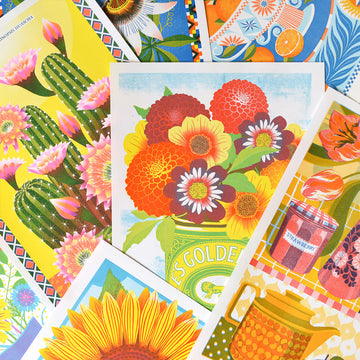


Vibrant spot colours
A Risograph is a digital duplicator invented in Japan in 1958. It’s a very economic printing method and uses a stencil to make duplicates. The stencil is wrapped around a rotating print drum that pushes soy ink through the screen and onto the paper. Like screen printing, Risographs lay down just one colour at a time, to achieve a multi-colour print the paper must be passed though the machine with a different colour drum for each layer.

One layer at a time
Riso inks are translucent, making them perfect for colour mixing by overlaying the spot colours to create new ones. Movement between the colour layers makes Risograph printing inherently imperfect. The similarities between screen printing and Risograph printing make it an easy transition for printmakers who already work with individual colour layers. Risograph has seen a huge resurgence with artists and designers due to the affordable price point, the bright colours, unusual print texture and combination of analog and digital processes.

Getting started
We were lucky to be part of Print the the People, an open access printmaking studio here in Norwich which at the time had a Riso printer and a small number of colour drums. This gave us a chance to see hands on what this wonderful process was all about.
We quickly realised the potential for translating screen prints into Risographs and that we wanted access to more colours. We started sending our designs off to various Riso studios in the UK. We’ve been working with Earthbound Press for many years now and we couldn’t be happier with the results.
To find out more do read our Q&A with Antonia from Earthbound Press!

Our riso prints
Our Riso prints are produced in open editions on 170gsm Munken Lynx in 2 to 5 colour layers. Each print now comes with a process information slip with details of the spot colours used and a little bit about the print process.










